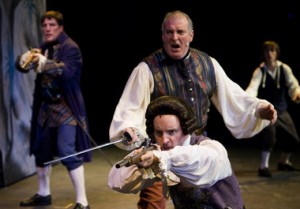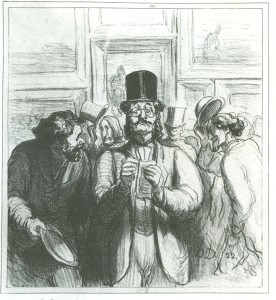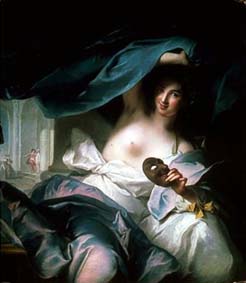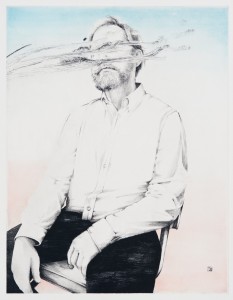THE MORNING AFTER — It’s a rare and wonderful thing to be in a room filled with love the way that Lincoln Performance Hall was last night for the celebration of Jim Caputo’s life. The hall was filled to overflowing, which must have meant about 700 people were on hand for a night of music, videos (including Caputo’s infamous and oft-repeated dance steps, and his belly-rolling routine that eventually made it onstage in “The Full Monty”), reminiscences and food. It was a bringing-together of a very broad clan, and Jim was the thread that united the pieces. It’s hard to say who’s more blessed: the man or woman who gives such a gift to a community, or the community that gratefully accepts the gift. Time after time, someone turned to someone else in the crowd and said, “Jimmy woulda loved this.” So he would have. It’s obvious that in the memories and lives of many people he’ll live on for a very long time.
By Bob Hicks
At last night’s loud and rousing celebration of the past season’s Portland theater, the Drammy Awards, Greg Tamblyn took time out from his outstanding-director acceptance speech to remind the crowd that it was a few people short this year, and especially, to his mind, it was missing Jim Caputo, the big-spirited actor who died at age 50 last month.
 Tamblyn and Caputo had been especially close — Greg directed Jimmy in more shows than you could count on the fingers of both of your hands — but Jim was in general one of the best-liked people on the city’s theater scene, a local boy who stuck around, learned well from the likes of the late great Peter Fornara, and became in turn a veteran hand always happy to help the next generation. In fact, he spent a lot of time doing shows with young actors at Oregon Children’s Theatre and elsewhere.
Tamblyn and Caputo had been especially close — Greg directed Jimmy in more shows than you could count on the fingers of both of your hands — but Jim was in general one of the best-liked people on the city’s theater scene, a local boy who stuck around, learned well from the likes of the late great Peter Fornara, and became in turn a veteran hand always happy to help the next generation. In fact, he spent a lot of time doing shows with young actors at Oregon Children’s Theatre and elsewhere.
Tamblyn reminded the crowd that there’ll be a celebration of Caputo’s life tonight, Tuesday, at Lincoln Performance Hall on the Portland State University campus. The gathering begins at 6 p.m., and the memorial a half-hour later. Caputo’s widow, Karen Voss, gives this advice: “Please no somber dress — let’s fill the room with the bright colors of his light and laughter.”
The Drammy Committee, among its many other services, published a memoriam list in last night’s program of theater people who have died in the past year. Besides Caputo, they include:
- Janet Bradley, the longtime and much-loved leader of Tears of Joy Theatre
- Jack Wellington Cantwell, a true gentleman, a Portlander, and a veteran of many seasons at the Oregon Shakespeare Festival
- Roger Cole
- Judi Dreier
- Bob Ellenstein
- Bruce Fraser
- Lannie Hurst, a genuine old-time leading lady
- Dale Long
- Kenneth Mars, the Hollywood star (The Producers, Young Frankenstein) who appeared onstage here with his daughter, Susannah Mars
- Katie Myers and Michael Myers, effusive and good-hearted mainstays of Portland TheatreSports, who were swept out to sea by waves on the south jetty at Yaquina Bay
- Bill Patton, the gentlemanly and supremely competent former executive director of the Oregon Shakespeare Festival, who began there when it was a little community summer theater and helped shape it into an internationally renowned company
- James Peppers
- Bob Rindt
- Billy Rose
Each one of these people was extremely important in the lives of a lot of other people, from families to coworkers to audiences. Take a moment to remember them and the many roles they played.
And we’ll see you tonight to reminisce about Jimmy.
*
Photo: Jim Caputo in “The Ghosts of Treasure Island” at Oregon Children’s Theatre. Leah Nash/Special to The Oregonian
 I have been a critic.
I have been a critic.
 Tamblyn and Caputo had been especially close — Greg directed Jimmy in more shows than you could count on the fingers of both of your hands — but Jim was in general one of the best-liked people on the city’s theater scene, a local boy who stuck around, learned well from the likes of the late great Peter Fornara, and became in turn a veteran hand always happy to help the next generation. In fact, he spent a lot of time doing shows with young actors at Oregon Children’s Theatre and elsewhere.
Tamblyn and Caputo had been especially close — Greg directed Jimmy in more shows than you could count on the fingers of both of your hands — but Jim was in general one of the best-liked people on the city’s theater scene, a local boy who stuck around, learned well from the likes of the late great Peter Fornara, and became in turn a veteran hand always happy to help the next generation. In fact, he spent a lot of time doing shows with young actors at Oregon Children’s Theatre and elsewhere.

 Friday’s A&E magazine of The Oregonian includes
Friday’s A&E magazine of The Oregonian includes  It was the second recent new contemporary dance piece in town in which the music was an essential and equal partner to the dancemaking, defining and pushing the ideas as much as the choreography itself. (The first was
It was the second recent new contemporary dance piece in town in which the music was an essential and equal partner to the dancemaking, defining and pushing the ideas as much as the choreography itself. (The first was  Bokashi, Storm Tharp/PDX Contemporary Art
Bokashi, Storm Tharp/PDX Contemporary Art So of the 40 zillion or so images we might show you, we’ve chosen just one: Storm Tharp’s Bokashi, above, a 2011 softground print in an edition of 12 in the group show Oomph at
So of the 40 zillion or so images we might show you, we’ve chosen just one: Storm Tharp’s Bokashi, above, a 2011 softground print in an edition of 12 in the group show Oomph at